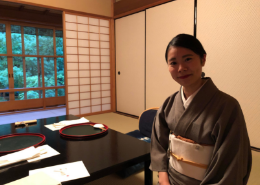How the Japanese Tea Ceremony Mirrors the Author/Reader Relationship
 On our recent trip to Asia I barely scratched the surface of omotenashi, the Japanese spirit of hospitality, but I did have the opportunity to participate in a tea ceremony which gave me a glimpse. As I lay awake that night combatting jet lag, I began to see parallels between the author/reader relationship and the tea ceremony. This might be the type of idea that only seems brilliant at 3am… but here goes…
On our recent trip to Asia I barely scratched the surface of omotenashi, the Japanese spirit of hospitality, but I did have the opportunity to participate in a tea ceremony which gave me a glimpse. As I lay awake that night combatting jet lag, I began to see parallels between the author/reader relationship and the tea ceremony. This might be the type of idea that only seems brilliant at 3am… but here goes…
Omotenashi
The concept of service or hospitality runs very deep in Japan, the core being that each human encounter is unique and that every moment is once-in-a-lifetime. Each meeting, therefore, is entered into with great planning and intention. The height of the practice of omotenashi is a traditional tea ceremony. I must thank my dear friend Andy Goldfarb for introducing me to this concept before our departure.
The Tea Ceremony
The interaction begins before the guest arrives – with the host’s planning. She takes great care with the aesthetics: selecting the tea service, arranging the flowers, hanging a scroll. The details may consume the host’s thoughts before the meeting, but they are invisible to the guest, done without any expectation for appreciation.
When the guest arrives, the host kneels in front of a shrine to prepare the matcha with prescribed movements. She takes the tea vessel in her left hand and ladles the perfect amount of water over the green tea powder with fluidity and grace. She then rapidly whisks the mixture back and forth (approximately fifty times) until it is topped with a froth just so. She bows before passing the cup to the first guest who also shows great humility and appreciation for the final product. The guest is even expected to enjoy the last sip of tea with an audible slurp.
 The Ritual of Writing
The Ritual of Writing
As is the case with creating any art, there is a moment when the artist (or novelist in my case) begins to consider her audience. Revisions and edits to early drafts serve the piece, making language more clear, and conveying ideas with nuance and subtlety. Achieving refinement and simplicity requires the writer do more work. It’s not always what the host or writer does, but sometimes what she decides not to do that makes all the difference. Just like spending time selecting the correct tea set, the writer does not expect nor necessarily desire the reader to know everything that went into the preparation. It’s an unspoken contract between us that immense intention was involved.
One of the most satisfying things about writing fiction is using my imagination as an instrument. I picture a cloud of energy forming then percolating in my brain, finding its way out through my fingers typing on my keyboard – sort of like whisking green tea into a froth? I work to perfect my craft, ladling just enough action to mix with character detail. When the final product is ready, it is my offering to readers.
Readers take the vessel in hand and turn it, appreciating the cover art. If they are willing,they consume it, and voila: my imagination and stream of energy finds a path to theirs. If they really enjoy the book – and hopefully they do – they might finish with a big healthy slurp that sounds something like a five star review.
So like the master of the tea ceremony, working to tend the aesthetic of her tea garden, I sit down to write each day, aware that each sentence I craft is unique to this moment, and attuned to my experiences. I bow in humility to each reader who, like the guest at the ceremony, is willing to accept this version of omotenashi and drink from my cup.

 The Ritual of Writing
The Ritual of Writing







Leave a Reply
Want to join the discussion?Feel free to contribute!